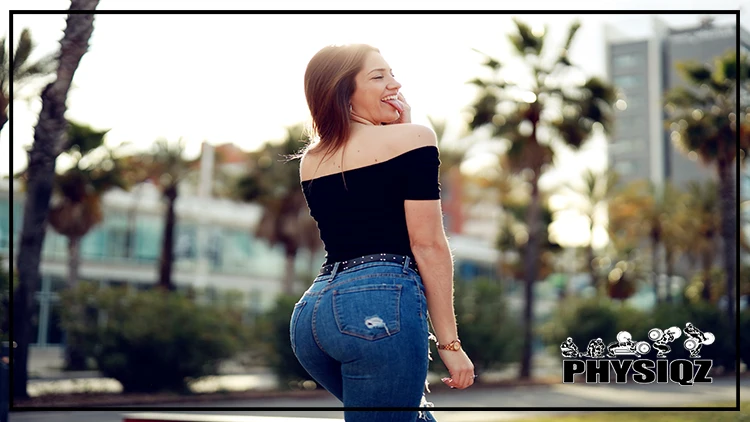
Understanding how to build up the upper glutes can make all the difference in developing a rear end you’re proud of.1
Below we’ll detail the best exercises to build the upper glutes, diet tips, the anatomy of the upper glutes, and if it’s even possible to target just the upper glutes.
And to bring it all together, there’s even a glute building workout program below to get you started on the journey to building a plump rump!
Is It Possible To Target Your Upper Glutes Alone?
To build a shelf booty, weightlifters need to focus on upper glute activation. However, it’s impossible to target just the upper glutes.
This isn’t a bad thing, however. The glutes are composed of three different muscles: the gluteus maximus, gluteus minimus, and gluteus medius.
For a healthy, strong posterior, all three muscles need to be utilized on a regular basis.2 But by experimenting with exercise variations and choosing options that suit the unique anatomy of the lifter, emphasis can be safely placed on the upper glutes.
The Anatomy of Your Glutes & Why Developed Glutes Create a Heart-Shaped Appearance
A heart-shaped appearance is a coveted look in today’s world. Celebrities with thick upper glutes and tiny waists have grown massive followings in recent years, sparking interest in the development of heart-shaped booties around the globe.
While genetics dictate butt shape to a great extent, weightlifters can make their butts more heart shaped by correcting any muscle imbalances between the three different glute muscles. A well-developed gluteus medius in particular will broaden the upper butt, creating the popular heart shape.
However, all three muscles play a role:
Upper Glute or the Gluteus Medius: The gluteus medius is a broad muscle situated at the top of the butt. Its lower third is covered by the gluteus maximus.3
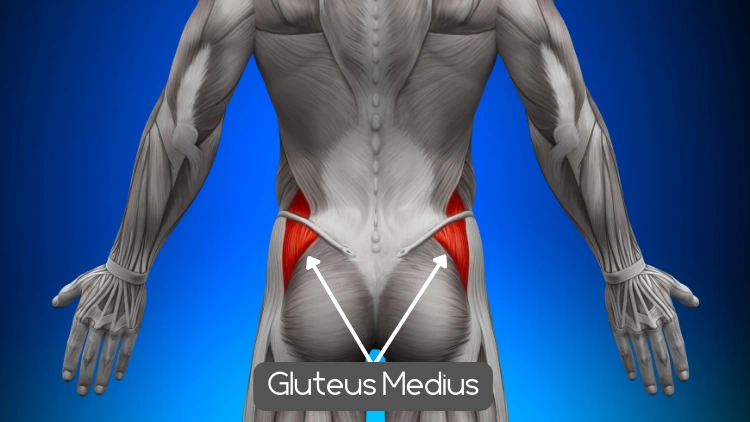
Source: decade3d via Canva.com4
This muscle has multiple roles, including helping to lift the leg forward while walking, externally rotating the hip, and stabilizing the entire pelvis. Exercises like step-ups and lunge and squat variations will engage glute med.
Mid or Center Glute or the Gluteus Maximus: As the largest muscle in the body, the gluteus maximus is responsible for enabling human beings to stand and walk on two legs instead of four! Its main function is hip extension, or lifting the leg behind the body.5
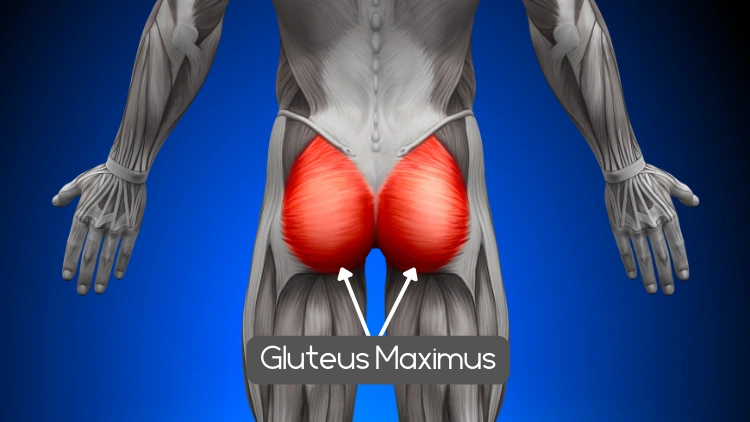
Source: decade3d via Canva.com6
Bridges, hip thrusts, sprinting, and kettlebell swings target this powerful muscle.
Lower Glute or the Gluteus Minimus: Positioned underneath the gluteus medius, the gluteus minimus is, unsurprisingly, the smallest of the glute muscles.7 This doesn’t mean it’s unimportant, though!
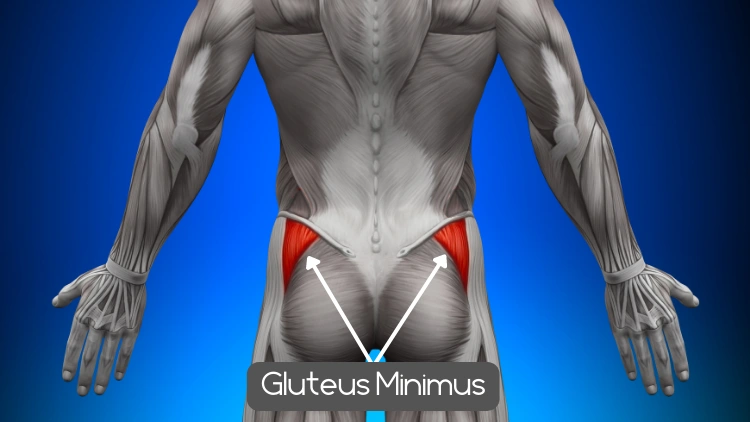
Source: decade3d via Canva.com4
This muscle plays a key role in balance, stability, and internal hip rotation. It can be targeted with many single-leg exercise variations, including single-leg deadlifts.
Body Weight Exercises for a V-Shaped Glute (Top Glute Exercises That Can Be Done at Home)
These five effective exercises targeting the upper glutes can be performed at home without any special equipment. Keep in mind that for bodyweight exercises, higher rep ranges will typically be more appropriate than for weighted exercises.
Glute Pre-Exhauster: Glute Bridge Pulses
Warm up the glutes and get a burn going in a few seconds with this simple exercise. Lay down and plant the feet hips width distance apart.
Drive hips up, using shoulders and arms for stability. Pulse into full extension without allowing the hips to touch the ground until the set is completed.
Bodyweight Side Lying Hip Raise
This exercise is a lot harder than it looks! It may be the best of all bodyweight workouts targeting the upper glutes.
It strengthens the shoulders too. In a side-lying position on the forearm, bend the knees to 90 degrees and hinge the hips slightly.
Drive the hips off the floor, pressing into the forearm and the grounded shin. Lift the top leg as high as possible from the hip. Return to the starting position to complete one rep.
Deficit Bulgarian Split Squats
Full range Bulgarian split squats engage the glutes as effectively as hip thrusts.8 Add a deficit for even more glute activation!
Plant the front foot on a firm surface elevated 1-3 inches from the ground. Place the top of the rear foot on a firm surface at approximately knee height (a chair, firm ottoman, or firm couch will work).
Hinge at the hips and lunge, lowering the rear knee as close to the floor as possible. Aim for a deep stretch in the lower booty. Press through the front heel to return to the starting position.
Elevated Single Leg Bridges
This exercise can be done almost anywhere. It exhausts the gluteus maximus quickly, requiring the gluteus medius to assist. Expect a serious burn in the underbutt muscles as well! Lay down and plant one foot or heel on a firm, elevated surface.
Drive hips upwards, stabilizing with the arms and pausing in full hip extension. Lower all the way to the floor to complete one rep.
Experiment with the distance between the grounded foot and the hips to find maximal glute engagement.
Single Leg Hip Thrusts
If you want to build and define your upper glutes, this exercise is essential.
At the gym, use a bench or box that is approximately knee height. At home, substitute a firm ottoman, couch, or step.
Use the upper back for support and drive through the planted heel, lifting the hips to full extension with assistance from the lifted leg. Rest butt all the way to the floor to complete one rep.
Banded Exercises for Shaping the Upper Glutes
If you’re looking for exercises to lift your buttocks, starting with bands is an excellent option.
They’re an indispensable tool to get a rounder butt. Get a selection of different bands, in both plastic and cloth, so that exercises can be scaled and progressed as appropriate.
Banded Donkey Kicks
This exercise exhausts the gluteus maximus and develops strength and stability in the core as well. Place a thick elastic band just above the knees in table position.
Use the grounded knee to pin the band in place while kicking the other leg up. Maintain a 90 degree bend in both knees.
Return the lifted knee to the floor to complete one rep. Keep the low back neutral and the core engaged.
Banded Standing Hip Abduction
This exercise is an accessible starting point if you’re wondering how to transform a square-shaped bum into a round one.
In both abduction and adduction exercises, it’s important to experiment with different stances and band placements to find maximal glute engagement.9
For this variation, stand with a mini band around the ankles or above the knees. Kick one leg out to the side, stabilizing with the other leg to avoid shifting the hips from side to side.
Return to the starting position to complete one rep.
Banded Glute Kickbacks
Pair this exercise with banded standing hip abduction as a killer superset. Stand with a mini band around the ankles or above the knees.
Place the hands on the wall or a heavy chair for support, then kick one leg back as far as possible. Maintain a slight bend in the standing knee and a consistent slight hinge at the hips.
Return to the starting position to complete one rep.
Seated Banded Hip Abduction
While this exercise might look easy, after a few reps the upper glutes will be on fire! Sit on a chair that allows the knees to maintain a 90 degree bend.
Place a thick band just above the knees. Position the feet hips width distance apart.
Pulse the knees outward, keeping the feet in the same place. Experiment with varying degrees of hip hinging.
Higher rep ranges (30-50) are appropriate for this exercise.
Glute Finisher: Banded Pulse Squats
Add this exercise to the end of a workout to completely exhaust the glutes. Place a band just above the knees and lower into a squat with feet hips width distance apart and toes turned out slightly.
Without standing up completely, pulse in and out of a low squat, driving the knees out against the band constantly. Do not let up tension on the band or exit the squat until all reps are completed.
Weighted Compound Exercises (the Best Exercises for the Upper Glutes)
While bodyweight and banded exercises are effective for upper glute development, weighted compound exercises will deliver the most dramatic results in the least amount of time.
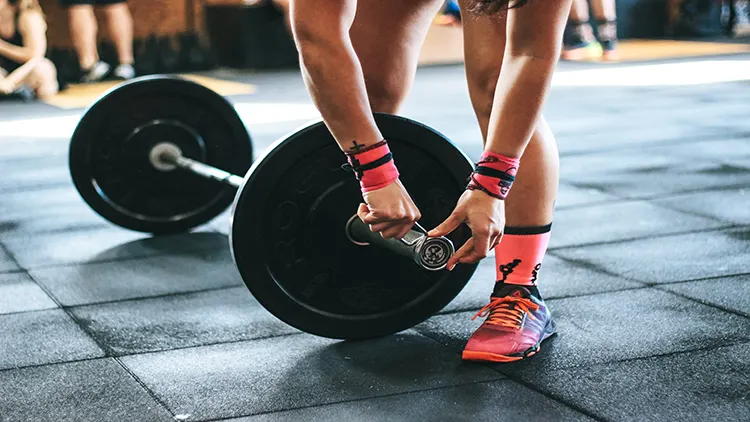
Source: Victor Freitas via Unsplash10
These exercises can be performed at almost any gym, and there are many options to accommodate variations in available equipment.
Dumbbell 45 Degree Hyperextensions
While this exercise may look silly, it will light up the upper glutes, center glutes, and lower butt all at once! Position a hyperextension bench to the appropriate height.
Plant the feet firmly on the bench with toes turned out slightly. Hold a dumbbell goblet style at the chest.
Hinge forward, keeping the spine slightly rounded and holding the dumbbell against the chest the entire time. Press through the heels to extend the hips, squeezing the glutes powerfully and pressing thighs into the bench.
Lower back into a hip hinge to complete one rep.
Sumo Deadlifts
Sumo deadlifts are an excellent compound lift to target the upper glutes. Be sure to warm-up adequately before attempting this exercise as it requires a great deal of flexibility in the hips.
Find a wide stance with toes turned out and knees driving out. Toes and knees should point in the same direction on each respective side.
Roll a barbell loaded with bumper plates against the ankles and sit the hips back to grip the hands around the bar. Keep the spine neutral.
Drag the bar along the legs while pressing through the heels to stand up, keeping the knees moving outward the entire time. Lower the bar back along the legs to return it to the floor.
Barbell Back Squats
While much could be written about the many benefits of barbell back squats, they will always remain an effective way to build mass in the glutes. For most people, selecting a full-range variation with a wide, open stance will generate the most glute engagement.
Work on bringing the thighs parallel with the floor (or lower!) and bending the knees and hips equally. A spotter – in the form of a workout partner or spotter arms on the rack – may increase confidence for lower squats.
Dumbbell Bulgarian Split Squats
Single leg training is essential for building the upper glutes. For this exercise, plant your front foot firmly and place the top of your rear foot on a stable surface, such as a bench or box, at about hip height.
Hold a dumbbell in each hand with relaxed shoulders and arms. Hinge at the hips and lunge, lowering the rear knee as close to the floor as possible.
Press through the front heel to return to starting position.
Barbell Hip Thrusts
When it comes to overall glute development, few exercises are as important as the barbell hip thrust. A 16” box, barbell pad, and bumper plates are needed if the gym doesn’t have a hip thrust bench or machine.
Sit on the floor and rest the upper back against the edge of the box. It’s best to brace the box against the wall or a power rack. Roll a loaded barbell across the hips.
Use the hands to stabilize the bar as the hips drive toward the ceiling into full hip extension.
Press through the heels and keep the feet parallel in a hips width distance position. Look forward or toward the ceiling, but don’t arch the back. Return the bar to the floor.
There are many variations of hip thrusts that are worth experimenting with to find the most glute engagement.
How To Improve Your Glute Workouts by Fixing Sleepy Butt Syndrome (Glute Amnesia)
Many people struggle to feel glute engagement, even in exercises that should exhaust the butt muscles. These three tips will ‘wake up’ sleepy glutes and increase muscular engagement as a result.
Focus On Mind Muscle Connection: Instead of rushing through a workout, chatting, or getting sidetracked by social media, try to slow down and focus on really feeling muscular engagement in each rep. It might be helpful to turn off the loud music and find an uncrowded spot in the gym.
With practice, the relationship between the mind and the glute muscles will strengthen.
Try Activation Sets or Pre-Exhaust Sets: Research indicates that glute activation warm-ups can increase glute engagement throughout the entire workout.11 Try using any of the exercises from the bodyweight or banded exercises sections of this article as a warm-up before lifting weights.
Stair climbing is a great cardio warmup option as well.
Give a Few Variations a Shot: Sometimes feeling the glutes work is as simple as shifting foot placement, adding a band, or increasing the range of motion in a given exercise. If a prescribed exercise feels ineffective, experiment with variations until the glutes start to burn!
Transforming a Square Bum into a Round One with a Healthy Diet
It’s not enough to just murder the glutes at the gym on a regular basis. Muscles cannot grow without sufficient calories and protein.
Many people make the mistake of not eating enough to support enhanced glute development. Don’t throw away all that effort!
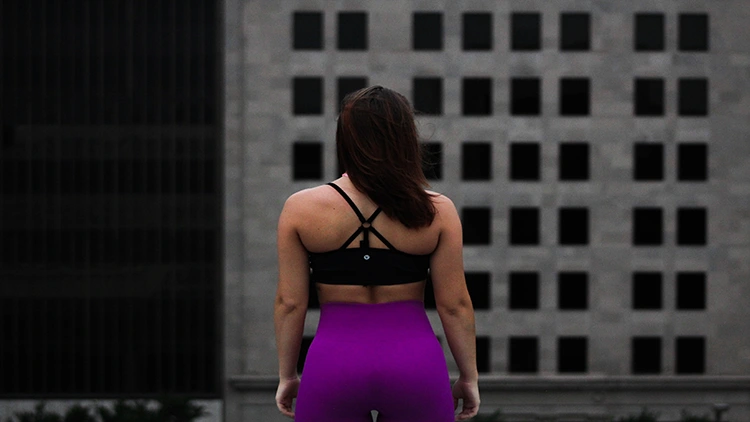
Source: Parker Mauk from Unsplash12
Aim for at least 1 gram of protein per pound of bodyweight per day.13 The complete proteins found in animal products are most easily utilized by the body, but vegetarians and vegans can grow lots of muscle too.
They may require increased daily protein intake, however.
Space this protein out into 3-5 balanced meals, including carbs like rice and potatoes, healthy fats like coconut oil, olive oil, and nuts, and lots of fruit and vegetables. If weight fluctuations continue, explore methods for maintaining weight without counting calories.
The Six (6) Week Glute Workout & Exercise Routine Proven To Build a Shelf Butt
This program is designed to enhance the upper glutes, and even if you miss a day or two, you can simply resume where you left off to gain the full benefits. It can be done at any standard commercial gym or at home if you have barbells, bands, and dumbbells.
Warm-up before each workout with ten minutes of moderate cardio or stretching. Perform the first two exercises as straight sets and the remaining exercises as supersets.
Rest for 1-3 minutes between exercises. Keep a paper or digital logbook of weights used as a reference for progressing each exercise.
Each workout includes two core exercises to help tighten the waist and promote the development of a toned and sculpted butt.
Note, while each week has the same exercises, the intensity or % of 1RM increases to be sure you’re progressively overloading. And if you don’t know your 1RM, just try hard on the first week to get the suggested rep count and use this 1RM calculator to figure out your 1RM, and then adjust for the % the week calls for.
For example, if your 1RM on squats is 100 pounds if the program calls for 60% of your 1RM, then you will perform the exercise with 60 pounds which is 60% of 100.
Plus, the number of sets will increase slightly too so week 1 will be a lighter load than week 5. If at anytime you feel pain or extreme fatigue for days at a time, take a few days off and consider speaking to a healthcare professional.
That being said, let’s dive into it.
Weeks 1-2
Focus on low to moderate intensity these weeks. Learn how to do the exercises with good form and experiment with appropriate weights.
Note, when it says 2 x 5 this means 2 sets of 5 reps. So 2 sessions of 5 reps of the given exercise.
Day 1:
- Sumo Deadlifts: 2 x 5
- Dumbbell 45 Degree Hyperextensions: 2 x 12
- Single Leg Hip Thrusts: 2 x 15 each leg
- Seated Banded Hip Abduction: 2 x 30
- Forearm Plank: 2 x 60 seconds
- Bicycle Crunches: 2 x 50
Day 2:
- Barbell Back Squats: 2 x 8
- Cable Glute Kickbacks: 2 x 12 each leg
- Banded Glute Bridge Pulses: 2 x 30
- Prone Hamstring Curls: 2 x 12
- Forearm Side Plank: 2 x 60 seconds each side
- Hanging Knee Tucks: 2 x 10
Day 3:
- Barbell Hip Thrusts: 2 x 6
- Dumbbell Bulgarian Split Squats: 2 x 8 each leg
- Bodyweight Side Lying Hip Raise: 2 x 15 each leg
- Elevated Single Leg Bridges: 2 x 12 each leg
- Glider Mountain Climbers: 2 x 30 seconds
- Russian Twists: 2 x 50
Day 4 (this workout can be performed at home as a circuit):
- Banded Donkey Kicks: 2 x 20 each leg
- Banded Standing Hip Abduction: 2 x 12 each leg
- Banded Glute Kickbacks: 2 x 15 each leg
- Seated Banded Hip Abduction: 2 x 20
- Banded Pulse Squats: 2 x 30
- Plank Hip Dips: 2 x 30
Weeks 3-4
This week, begin to increase intensity by following the guidelines listed below regarding compound lifts. For all other exercises, try to increase weight or reps or decrease rest time incrementally.
Note, the exercises are the same but the number of sets increase in weeks 3-4 in order to progressively overload and to increase the working volume. Therefore, it’s great to increase the weight or decrease the rest times some, but if not, the number of sets increases so you’re still making progress either way.
Day 1:
- Sumo Deadlifts: 3 x 5 at 60% of your 1RM (1 rep max)
- Dumbbell 45 Degree Hyperextensions: 3 x 12
- Single Leg Hip Thrusts: 2 x 15 each leg
- Seated Banded Hip Abduction: 3 x 30
- Forearm Plank: 3 x 60 seconds
- Bicycle Crunches:3 x 50
Day 2:
- Barbell Back Squats: 3 x 8 at 60% of your 1RM (1 rep max)
- Cable Glute Kickbacks: 3 x 12 each leg
- Banded Glute Bridge Pulses: 3 x 30
- Prone Hamstring Curls: 3 x 12
- Forearm Side Plank: 3 x 60 seconds each side
- Hanging Knee Tucks: 3 x 10
Day 3:
- Barbell Hip Thrusts: 3 x 6 at 60% of your 1RM (1 rep max)
- Dumbbell Bulgarian Split Squats: 3 x 8 each leg
- Bodyweight Side Lying Hip Raise: 3 x 15 each leg
- Elevated Single Leg Bridges: 3 x 12 each leg
- Glider Mountain Climbers: 3 x 30 seconds
- Russian Twists: 3 x 50
Day 4 (this workout can be performed at home as a circuit):
- Banded Donkey Kicks: 3 x 20 each leg
- Banded Standing Hip Abduction: 3 x 12 each leg
- Banded Glute Kickbacks: 3 x 15 each leg
- Seated Banded Hip Abduction: 3 x 20
- Banded Pulse Squats: 3 x 30
- Plank Hip Dips: 3 x 30
Week 5: Deload
This is a deload week designed to improve recovery and decrease the chance of injury.14 Either repeat the workouts from Week 1 (using the weights from Week 1) or rest from strength training and prioritize yoga, walking/hiking, swimming, or other gentle forms of physical activity.
Anyone can build a strong, heart-shaped butt. Follow the upper glute workout program described above, eat plenty of protein, and watch those upper glutes grow!
Developing well-defined upper glutes requires practice, discipline, and consistency, but anyone can achieve this by following these guidelines.
Frequently Asked Questions
Can I Learn How To Get a Shelf on the Upper Glutes Without Diet or Exercise?
The glutes may develop slightly in response to increased walking and general physical activity. Surgery is also an option, but is not advisable since the glutes can be grown with simple lifestyle changes.
Speak to a knowledgeable healthcare professional to explore surgical options and risks.
How Often or Frequently Should I Workout Upper Glutes? Should I Workout Glutes Everyday?
Aim to target the glute muscles 3-5 times per week. Workout frequency should be adjusted according to how well the muscles recover. Excessive soreness, fatigue, and pain are signs to scale back on exercise frequency.
How Many Reps Should I Do When Working Out Upper Glutes?
For bodyweight and banded exercises, rep ranges between 15-50 are typically the best choice. For weighted exercises, stick to lower rep ranges.
Perform some exercises in the 3-6 rep range and some exercises in the 8-15 rep range.
How Many Sets of Glute Work Should I Do in a Single Workout?
Aim for 9-15 sets of glute exercises in a single workout. Vary the intensity of the exercises, including some compound weighted glute exercises, some banded glute exercises, and some bodyweight glute exercises.
How Long Does It Take To Get a Shelf on the Upper Glutes?
With appropriate training, sufficient calories and protein, and good recovery (quality sleep, stress management, and rest days), visible upper glute progress is possible in as little as six weeks! Most people will see dramatic results in their first year of training the glutes consistently.
How Do I Get My Glutes To Grow & Get Over a Plateau?
Use this checklist to assess the best way to get over a plateau:
- Am I eating enough calories?
- Am I eating at least 1 gram of protein per pound of bodyweight per day?
- Am I getting 7-8 hours of quality sleep each night?
- Am I training glutes 3-5 times a week?
- Am I challenging myself in my workouts and increasing reps and weight as necessary?
- Have I been doing these things consistently for at least six weeks?
How Can I Learn How To Get a Rounder Butt?
Find exercise that’s enjoyable and stick with it! Improve diet quality and prioritize consistency above everything else.
Take progress pictures so that it’s easy to track changes in appearance.
References
1“woman wearing black off-shoulder top and blue denim bottoms photo – Free Jeans Image on Unsplash.” Unsplash, 4 June 2019. Accessed 20 April 2023. <https://unsplash.com/photos/QmPmJhreK7o>
2Moore, D., Semciw, A. I., & Pizzari, T. (2020, Dec). A SYSTEMATIC REVIEW AND META-ANALYSIS OF COMMON THERAPEUTIC EXERCISES THAT GENERATE HIGHEST MUSCLE ACTIVITY IN THE GLUTEUS MEDIUS AND GLUTEUS MINIMUS SEGMENTS. International journal of sports physical therapy, 15(6), 856-881. <https://pubmed.ncbi.nlm.nih.gov/33344003/>
3Shah A, Bordoni B. Anatomy, Bony Pelvis and Lower Limb, Gluteus Medius Muscle. [Updated 2022 Nov 28]. In: StatPearls [Internet]. Treasure Island (FL): StatPearls Publishing; 2022 Jan-. Available from: <https://www.ncbi.nlm.nih.gov/books/NBK557509/>
4decade3d. “Glutes Medius – Anatomy Muscles.” Canva. Accessed 12 April 2023. <https://www.canva.com/photos/MAC_U4VEw9o-glutes-medius-anatomy-muscles/>
5Elzanie A, Borger J. Anatomy, Bony Pelvis and Lower Limb, Gluteus Maximus Muscle. [Updated 2022 Mar 28]. In: StatPearls [Internet]. Treasure Island (FL): StatPearls Publishing; 2022 Jan-. Available from: <https://www.ncbi.nlm.nih.gov/books/NBK538193/>
6decade3d. “Gluteus Maximus – Anatomy Muscles.” Canva. Accessed 12 April 2023. <https://www.canva.com/photos/MADerAJvWMU-gluteus-maximus-anatomy-muscles/>
7Greco AJ, Vilella RC. Anatomy, Bony Pelvis and Lower Limb, Gluteus Minimus Muscle. [Updated 2022 May 29]. In: StatPearls [Internet]. Treasure Island (FL): StatPearls Publishing; 2022 Jan-. Available from: <https://www.ncbi.nlm.nih.gov/books/NBK556144/>
8McCurdy, K., Walker, J., Kelly, C., & Polinski, M. (2021). Hip and Knee Extensor Activation During the Hip Thrust and Rear-Foot-Elevated Split Squat in Trained Females. Journal of strength and conditioning research, 35(5), 1201-1207. <https://pubmed.ncbi.nlm.nih.gov/33900255/>
9Peduzzi de Castro, M., de Brito Fontana, H., Fóes, M. C., Santos, G. M., Ruschel, C., & Roesler, H. (2021). Activation of the gluteus maximus, gluteus medius and tensor fascia lata muscles during hip internal and external rotation exercises at three hip flexion postures. Journal of bodywork and movement therapies, 27, 487–492. <https://pubmed.ncbi.nlm.nih.gov/34391276/>
10Victor Freitas. “person locking gym plates on barbell photo – Free Fitness Image on Unsplash.” Unsplash, 20 January 2018. Accessed 12 April 2023. <https://unsplash.com/photos/KIzBvHNe7hY>>
11Parr, M., Price, P. D., & Cleather, D. J. (2017, July 24). Effect of a gluteal activation warm-up on explosive exercise performance. BMJ Open Sport Exerc Med., 3(1), 1. <https://pubmed.ncbi.nlm.nih.gov/28761719/>
12Parker Mauk. “woman standing in front of gray building during daytime photo – Free Fitness Image on Unsplash.” Unsplash, 22 August 2017. Accessed 12 April 2023. <https://unsplash.com/photos/9szoeKnI1Uo>
13Stokes, T., Hector, A. J., Morton, R. W., McGlory, C., & Phillips, S. M. (2018, February). Recent Perspectives Regarding the Role of Dietary Protein for the Promotion of Muscle Hypertrophy with Resistance Exercise Training. Nutrients, 10(2), 180. <https://www.ncbi.nlm.nih.gov/pmc/articles/PMC5852756/>
14Lorenz, D., & Morrison, S. (2015). CURRENT CONCEPTS IN PERIODIZATION OF STRENGTH AND CONDITIONING FOR THE SPORTS PHYSICAL THERAPIST. International journal of sports physical therapy, 10(6), 734–747. <https://www.ncbi.nlm.nih.gov/pmc/articles/PMC4637911/>